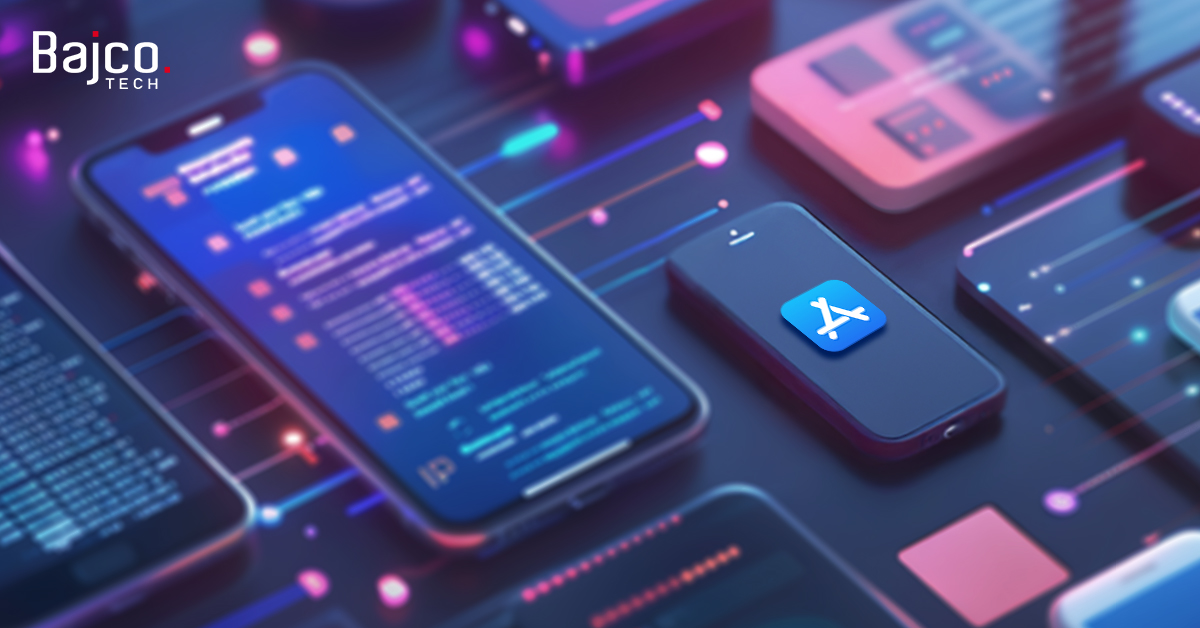The cost of developing an iOS app in 2025 still depends on one big question is what exactly are you building?
While AI tools and low-code platforms have made some tasks faster, custom iOS app development remains a serious investment. Businesses are still hiring experienced development teams to build apps that are secure, scalable, and aligned with their goals.
Here’s a basic cost range in 2025:
- A simple iOS app (like a calculator, checklist, or content viewer) costs between $20,000 and $40,000
- A medium-complexity app (think booking systems, maps, dashboards, API integration) will range from $40,000 to $100,000
- A complex iOS app with backend systems, real-time features, or multi-user roles can cost anywhere from $100,000 to $300,000 or more.
These estimates include planning, design, coding, testing, and post-launch support.
In its latest research, Clutch reports that average app development costs in 2024–2025 have gone up by 20–30%, especially for projects requiring advanced integrations and AI features.
While templates and drag-and-drop builders exist, most professional businesses still choose custom iOS app development for performance, control, and user trust, especially in industries like finance, healthcare, retail, and hospitality.
What Affects the Cost of Developing iOS Apps in 2025?
At Bajco Technologies, we work with startups, agencies, and enterprises that come to us with the same big question: How much is this iOS app really going to cost us? And the honest answer is: it depends. The price of building an iOS app in 2025 depends on far more than just the number of screens or how long it takes to code.
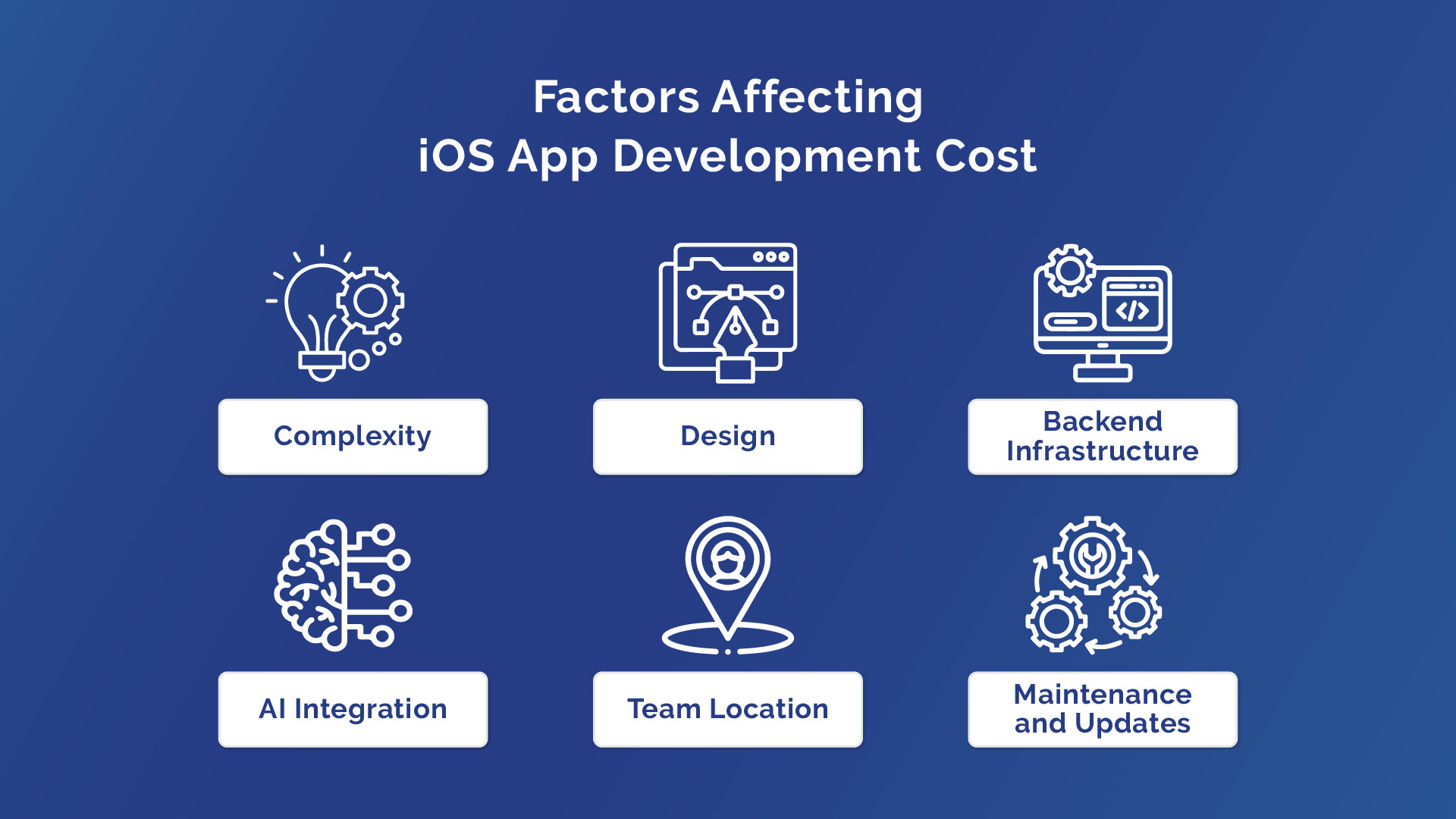
One of the biggest factors is complexity. Apps that perform simple functions like displaying content or taking user input are far more affordable than apps with live GPS tracking, payment processing, or messaging. As soon as you start introducing features like booking calendars, custom user profiles, or admin dashboards, you’re looking at significantly more time and technical planning.
The higher the complexity, the higher will be the design time which is another key factor that contributes to the iOS app development cost. Apps with evolving scope or changing requirements usually take longer to finish. That’s why we work closely with our clients during the planning phase to define what’s essential now and what can wait. A focused launch roadmap almost always saves money.
Understanding the stages of iOS app complexity and their associated costs is crucial for effective budgeting. Here’s a breakdown based on industry data:
Simple iOS Apps
Description: These apps offer basic functionalities without the need for complex features or backend support. Examples include calculators, note-taking apps, or basic informational apps.
Estimated Cost: $5,000 – $50,000
Development Time: Approximately 2 – 4 months
Moderate Complexity iOS Apps
Description: These apps have more features, such as user authentication, integration with APIs, or a custom user interface. Examples include e-commerce apps, social media platforms, or apps with real-time data synchronization.
Estimated Cost: $50,000 – $120,000
Development Time: Approximately 4 – 6 months
Complex iOS Apps
Description: These apps require advanced features like real-time synchronization, custom animations, complex backend infrastructure, or integration with emerging technologies such as AR/VR. Examples include large-scale enterprise applications, advanced gaming apps, or apps with extensive data processing needs.
Estimated Cost: $120,000 – $300,000+
Development Time: Approximately 6 – 12+ months
Design matters too. In today’s market, users expect polished and intuitive experiences. A clean, fast interface isn’t just “nice to have”—it can make or break your app. If you want your product to stand out on the App Store, you’re probably investing in professional UI/UX, and that’s reflected in the cost. At Bajco Technologies, we’ve seen time and again how better design leads to better reviews, longer session times, and lower uninstall rates.
1. Basic Design
Description: Simple user interfaces with minimal interactive elements. Suitable for apps with straightforward functionalities like calculators or basic informational apps.
Estimated Cost: $3,000 – $15,000
Factors Influencing Cost:
- Limited number of screens
- Minimal animations or transitions
- Standard UI components
2. Mid-Level Design
Description: More intricate designs with multiple screens and interactive elements. Ideal for apps like e-commerce platforms or social networking services.
Estimated Cost: $15,000 – $35,000
Factors Influencing Cost:
- Custom UI components
- Integration of animations and transitions
- Responsive design for various device sizes
3. Complex Design
Description: Highly customized designs with advanced animations, extensive user interactions, and unique user experiences. Suitable for gaming apps, advanced productivity tools, or apps requiring a distinctive brand identity.
Estimated Cost: $35,000 – $200,000+
Factors Influencing Cost:
- Advanced animations and transitions
- Custom illustrations and graphics
- High-fidelity prototypes and user testing
The category of an iOS app plays a major role in determining its overall cost because each category comes with its own set of expectations, features, and technical requirements. For example, a healthcare app often requires data encryption and compliance with regulations like HIPAA, which adds complexity and cost. In contrast, a gaming app may need high-performance graphics and interactive features that demand more time in development and testing. At Bajco Technologies, we help clients understand how their app’s category influences everything from backend architecture to design complexity, so they can budget smarter and build with confidence.
The backend is another critical piece. Apps that store user data, sync across devices, or manage large volumes of traffic need reliable backend infrastructure. This means setting up secure servers, APIs, and databases—often using cloud platforms like AWS or Firebase. A simple app might not need any of that, but most business apps do, and that comes with ongoing costs for hosting and maintenance.
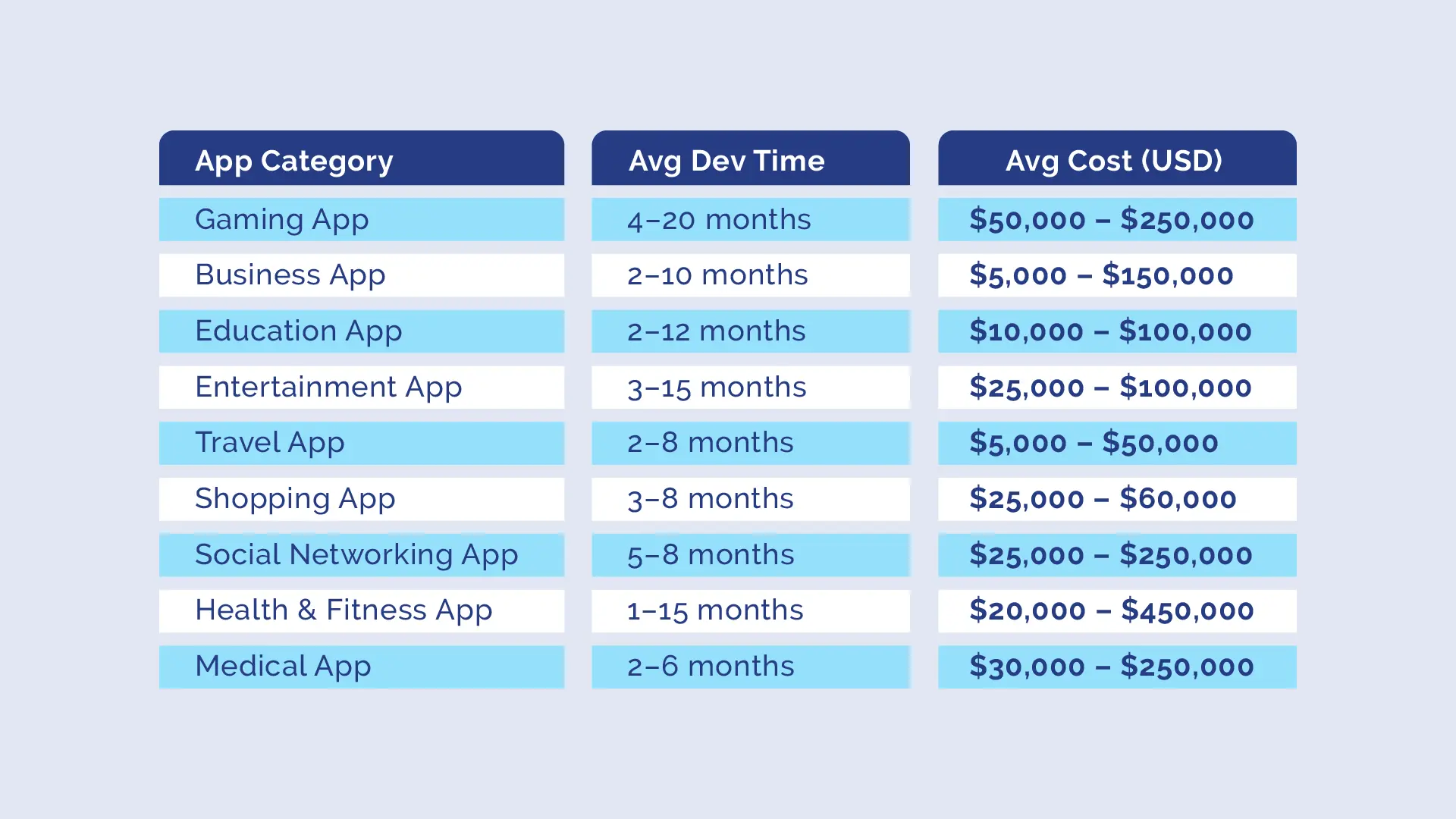
The features you choose to include in your iOS app have one of the biggest impacts on development costs. Simple apps with static content and limited interaction are relatively quick and inexpensive to build. But as soon as you introduce features like real-time chat, multi-user accounts, payment gateways, geolocation, or push notifications, the scope grows—along with the time and budget required.
In 2025, more businesses are also asking for AI-driven features. That adds an entirely new layer to app development. Whether it’s integrating AI chat support, personalized recommendations, or on-device transcription, AI increases both development and infrastructure costs. For example, using an AI model like GPT-4 for customer queries can cost up to $0.06 per 1,000 tokens processed. If your app processes thousands of interactions a day, those numbers add up fast. Plus, to make AI features work, your app needs access to the right data, which often means building additional layers into your backend.
It’s important to prioritize features that drive core value first, so you can launch lean, test faster, and avoid wasting resources on features users may not even need in the early stages.
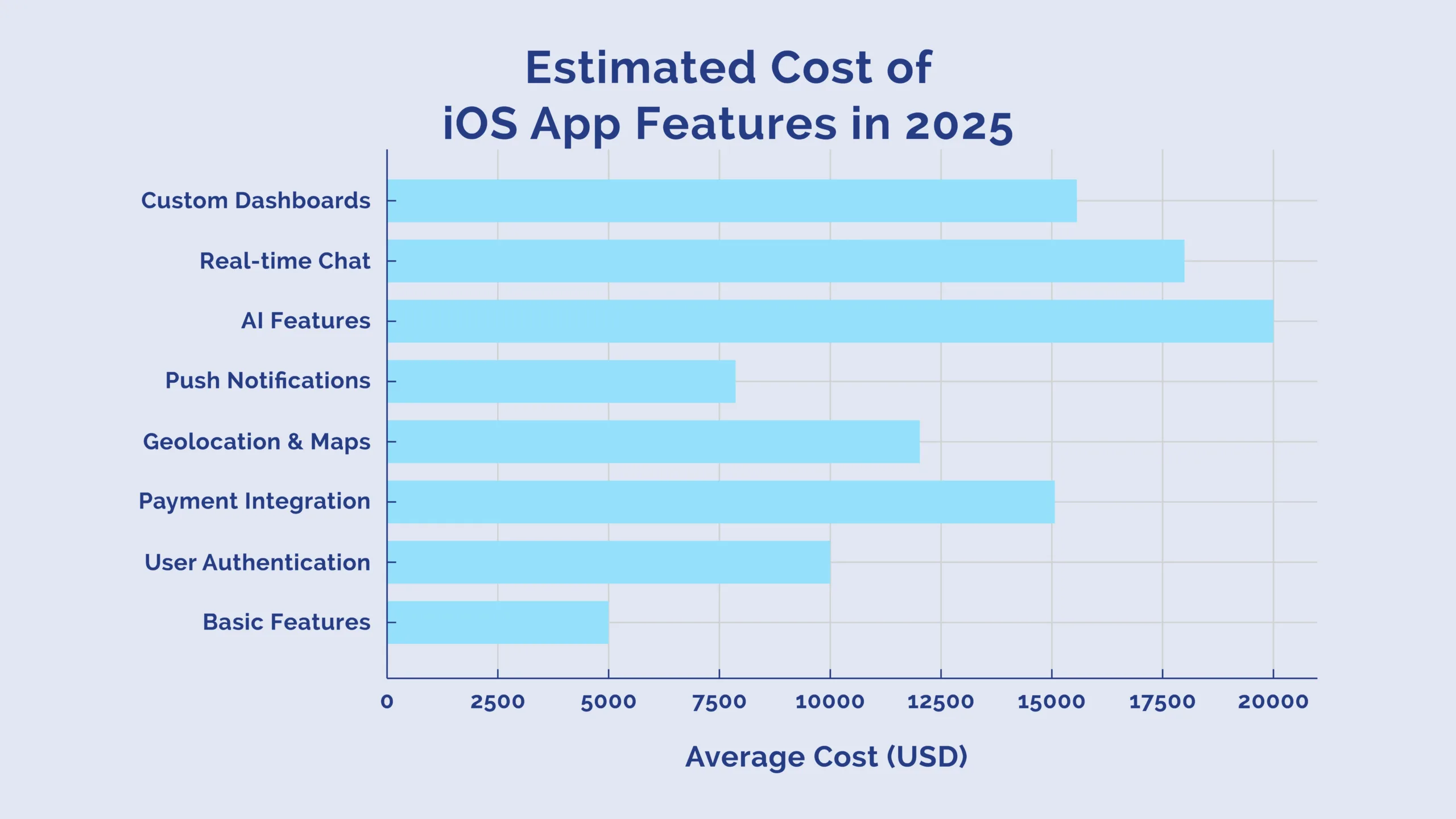
Source: Clutch App Development Pricing Guide 2025
Team location also plays a role. Hiring a US-based team can cost two to three times more than working with international developers. That doesn’t always mean better results, though. At Bajco, we use a hybrid model where senior engineers and product leads guide global delivery teams. That helps our clients get high-quality builds at more reasonable rates.
Finally, people often forget that costs don’t stop after launch. Maintenance is part of every software project. Whether it’s fixing bugs, updating the app for new iOS versions, or adding features based on user feedback, you’ll need a support plan in place. On average, post-launch maintenance costs businesses about 15–20% of their original development budget every year.
So yes, building an iOS app in 2025 involves more than just developers writing code. You’re budgeting for research, design, development, testing, infrastructure, AI tools, cloud services, app store fees, and future updates. That’s why we believe in honest conversations early on. Our goal at Bajco Technologies isn’t just to build apps, it’s to help you make smart technical decisions that make the most of your time and budget.
Cost Breakdown by iOS App Development Stages
When people ask us how much iOS app development costs, we always explain that it’s not just one big number. The total cost is made up of different stages, each one important, and each one with its own timeline, complexity, and price tag.
It usually starts with the planning stage. Before any code is written, there’s a phase called discovery. This is where we sit with clients to understand their goals, user flows, technical needs, and business model. We help define what needs to be built and how. For most iOS apps, this planning stage costs between $500 and $5000, depending on how detailed the project is.
Next comes design. In 2025, users expect fast, beautiful, and easy-to-use apps, and that’s where UI/UX design comes in. At this stage, designers create wireframes, layouts, and prototypes that show how the app will look and work. A basic design might cost as little as $3,000, but more custom or interactive designs often range from $10,000 to $30,000 or more.
Then the development begins. This is the core phase where your app is built; both the front-end (what users see) and the back-end (how the app stores data and communicates). The cost of this phase varies the most. A simple app might only take a few weeks, while a more advanced platform with AI, real-time features, and admin panels could take months. On average, development costs range from $20,000 to over $200,000 depending on the complexity. Business of Apps reports that the average custom app takes 4–6 months and costs around $100,000 to complete.
After development, every app goes through testing. This is where QA engineers make sure everything works properly across devices, screen sizes, and iOS versions. Bugs are fixed, edge cases are handled, and user experience is refined. Testing typically adds around 10–15% to the total cost of a project.
Once the app is working smoothly, it’s time to launch. Publishing an app to the App Store isn’t free — Apple charges $99 per year for a developer account. On top of that, there may be costs for marketing, legal review, or performance monitoring tools. This part is usually less expensive, but still important for a successful launch.
Finally, there’s post-launch support. This is one of the most forgotten stages but it’s also one of the most important. iOS updates roll out regularly, users find bugs, and business needs change. Maintaining and updating your app can cost $500 to $5,000 per month, depending on the size of the codebase and your support needs. A common rule of thumb is to budget about 15–20% of your original build cost per year for maintenance.
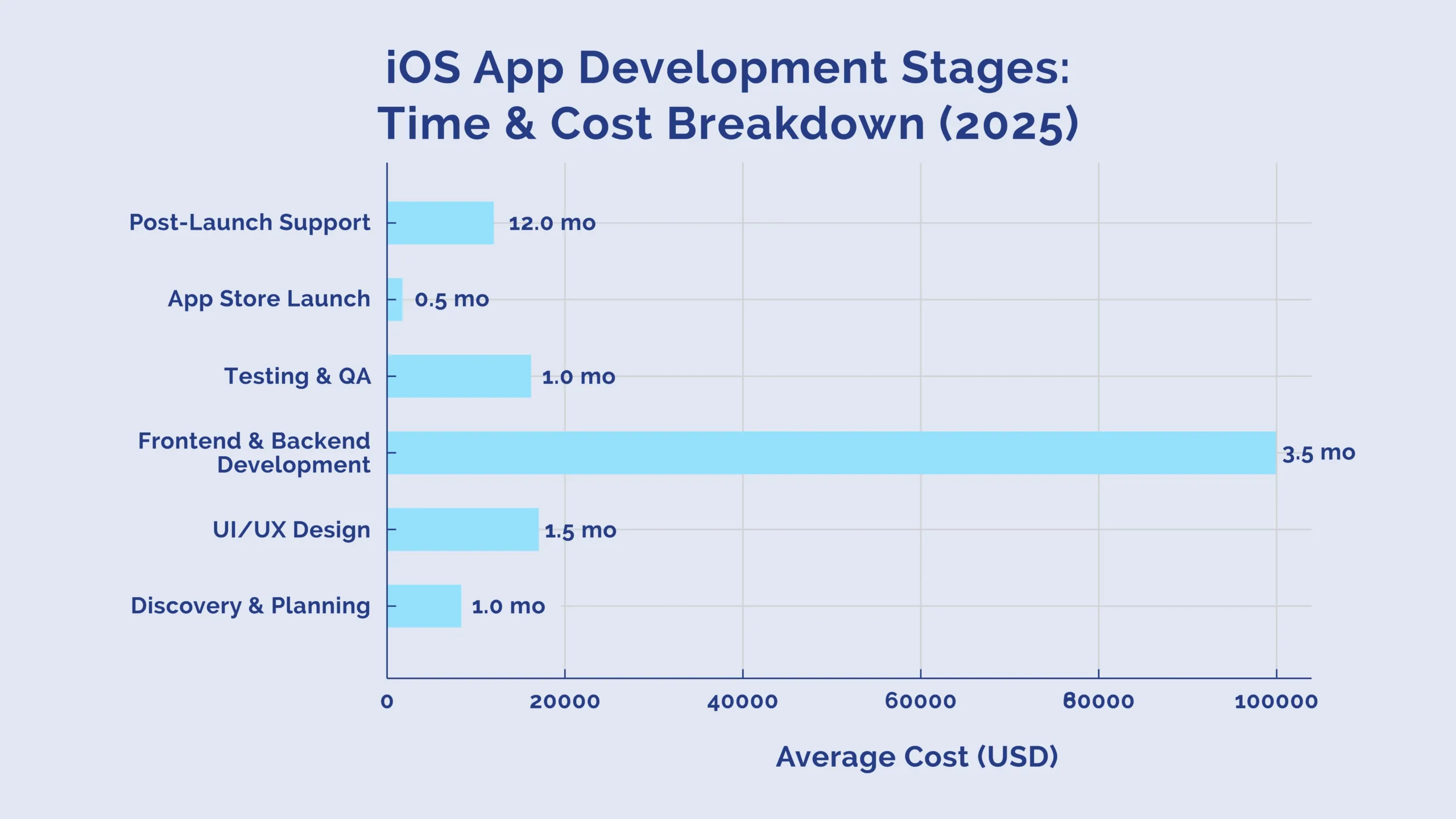
Hidden or Overlooked Costs in iOS App Development
When budgeting for an iOS app, it’s easy to focus only on design and development — the core phases you can see and track. But many businesses end up spending more than expected because of costs they didn’t see coming. These hidden expenses don’t always show up in early estimates, but they still impact your total investment.
One of the first overlooked costs is Apple’s own platform fee. If you’re planning to publish an app, you’ll need to enroll in the Apple Developer Program, which costs $99 per year. It’s not a huge amount, but it’s a recurring fee that every app owner must pay. If your app offers in-app purchases or subscriptions, Apple also takes a commission of 15–30% on each transaction, which can quickly reduce your profit margins.
Another often missed expense is cloud hosting and storage. Most apps today rely on cloud platforms like AWS, Firebase, or Google Cloud to store user data, handle authentication, and power real-time features. These services are usually priced based on usage, so as your user base grows, so do your cloud bills. A recent report by Flexera shows that 84% of companies consider managing cloud expenses as their top challenge in 2024.
Push notifications and SMS alerts also come with a price. While sending a few messages might seem free at first, apps that rely on constant communication with users often use services like Twilio or OneSignal. These tools charge based on volume, and for larger user bases, those monthly charges can add up fast.
Legal and compliance costs are another hidden area. If your app collects user data, even basic information like names or emails, you’ll need a privacy policy and terms of service. For apps handling payments, medical info, or personal data, you may need to comply with laws like GDPR, HIPAA, or PCI DSS. Drafting legal documents, hiring compliance consultants, or adjusting your infrastructure for regulations all come with costs, and skipping them can lead to even bigger penalties down the line.
Analytics and monitoring tools are also essential but rarely accounted for in early budgets. Once your app is live, you’ll want to track user behavior, measure performance, and find bugs in real time. Tools like Mixpanel, Amplitude, or Sentry offer valuable insights but usually come with monthly fees based on user count or data volume.
At Bajco Technologies, we guide our clients through these often-overlooked areas right from the start. That way, there are no surprises when the app is live and gaining traction. A smart budget isn’t just about development, it’s about long-term sustainability. The apps that last are the ones that plan for every layer, not just the code.
What If You’re Upgrading an Existing iOS App?
Not everyone is starting from scratch. In fact, many of our clients at Bajco Technologies come to us with an app that’s already live, but not quite where it needs to be. Maybe it was built years ago, or by a freelancer, or with a minimal MVP approach. Either way, upgrading an existing iOS app comes with its own set of costs, challenges, and opportunities.
The cost to upgrade depends entirely on what you want to change. If you’re just fixing bugs or updating the app for the latest iOS version, the cost might be relatively low, usually a few thousand dollars. But if you’re redesigning the UI, adding new features, optimizing performance, or switching from an outdated tech stack, the effort can be almost as involved as building from scratch.
A light upgrade, such as improving user experience, fixing navigation issues, or making the design feel more modern, typically falls in the $5,000 to $20,000 range. That includes design updates, minor feature enhancements, and App Store resubmission. But if your app needs a full technical overhaul, for example, migrating from Objective-C to Swift, refactoring inefficient code, or rebuilding the backend to handle more users, the cost could easily go beyond $50,000.
One of the biggest challenges in upgrading older apps is untangling code that was written without long-term scalability in mind. In those cases, we often recommend a hybrid approach i.e. keep what works, replace what doesn’t, and plan a phased rollout that doesn’t interrupt your users.
According to Clutch, nearly 30% of businesses end up redoing their mobile apps within 12–18 months because the initial version didn’t scale properly or failed to meet user expectations. That’s why we always focus on building (or rebuilding) with the future in mind: clean code, scalable infrastructure, and modular features that grow with your business.
If you already have an app and you’re unsure whether to patch it or rebuild it, we offer code audits and UX reviews to help you make a smart call. The right upgrade doesn’t just fix what’s broken, it sets you up to compete in today’s App Store.
AI has become so important in app development today that we couldn’t just mention it in passing, it needs its own section. That’s not just because it’s trending. It’s because users now expect apps to be smarter, faster, and more helpful, and most of that is powered by AI behind the scenes.
We see this constantly, whether we’re working on a retail, fitness, or productivity app, almost every client now asks: Can we add AI? It might be a chatbot, personalized recommendations, automatic summaries, or even voice recognition. But the request is almost always there, and it’s not surprising. AI has become the new normal, and apps that don’t evolve are quickly left behind.
AI Makes Development Faster and More Strategic
On the development side, AI is speeding things up. Tools like GitHub Copilot and ChatGPT help developers write code faster, fix bugs quickly, and even automate repetitive tasks. According to GitHub, developers using Copilot complete tasks up to 55% faster than those who don’t. That’s a big shift, and it helps reduce timelines, especially for standard features.
But AI doesn’t just help behind the scenes. Adding AI into your app, for example, a voice assistant, a recommendation engine, or a smart search bar can change how your users experience the app. It’s what makes an app feel intelligent, even personal. That kind of experience is what users love, and what keeps them coming back.
According to Gartner, mobile app usage is projected to drop by 25% by 2027 as users shift to AI assistants like Apple Intelligence, ChatGPT, and Gemini to perform tasks traditionally handled by apps. That’s why incorporating AI into apps isn’t just innovative, it’s necessary to stay relevant.
Smarter Features, Higher Expectations, Bigger Impact
Building smart features takes real planning. Users have started to expect more from apps that claim to use AI. They want smarter searches, helpful suggestions, and faster service. But that “smart” behavior doesn’t happen automatically. It takes data, training, and lots of testing. In 2024, Gartner predicted that 80% of smartphone users will regularly use AI-enhanced apps by the end of 2025, and that puts pressure on businesses to meet those expectations with polished, reliable AI-powered features.
You’ll need to decide how the AI works, where the data comes from, how it’s processed, and how secure it is. Many AI features also rely on APIs, like OpenAI’s GPT-4 or Google Cloud’s AI tools, which charge based on usage.
So, while AI improves the app’s usefulness, it also brings added infrastructure and maintenance needs. Apps that use AI need to monitor performance regularly, fine-tune how the model behaves, and stay on top of privacy rules.
The Investment Is Worth It, If You Use It Right
If you’re not thinking about AI in your app, chances are your competitors are and they’re already improving user retention and personalization because of it. But remember, adding AI to your iOS app isn’t something you do once and forget. AI models need to be monitored, refined, and sometimes re-trained. User data needs to be handled carefully, especially with evolving data privacy laws. That’s why we always recommend viewing AI as a long-term investment and not just a quick add-on.
At Bajco Technologies, we never suggest AI just because it sounds cool. We help clients figure out when it adds value, what’s feasible for their timeline and budget, and how to build it in a way that’s scalable. Because when AI is done right, it doesn’t just make your app smarter, it makes your business stronger.
How to Lower iOS App Development Costs Without Cutting Corners
Building an iOS app takes money, time, and serious planning. But not every successful app starts with a massive budget. In fact, the smartest companies launch lean, grow intentionally, and save their budget for what really matters.
We work with a lot of founders and product teams who want to get their apps to market without draining their resources. It’s doable as long as you make the right choices early on. Here’s how.
Start With a Lean MVP
You don’t need a perfect app on day one, you need a useful one. An MVP (minimum viable product) is the fastest way to get your idea in front of users without overbuilding. We’ve worked with clients who spent months and thousands of dollars building every feature they could think of, only to realize their users only cared about two.
What makes an MVP powerful is that it validates your idea. You get real feedback, early traction, and clarity on what your users actually want.
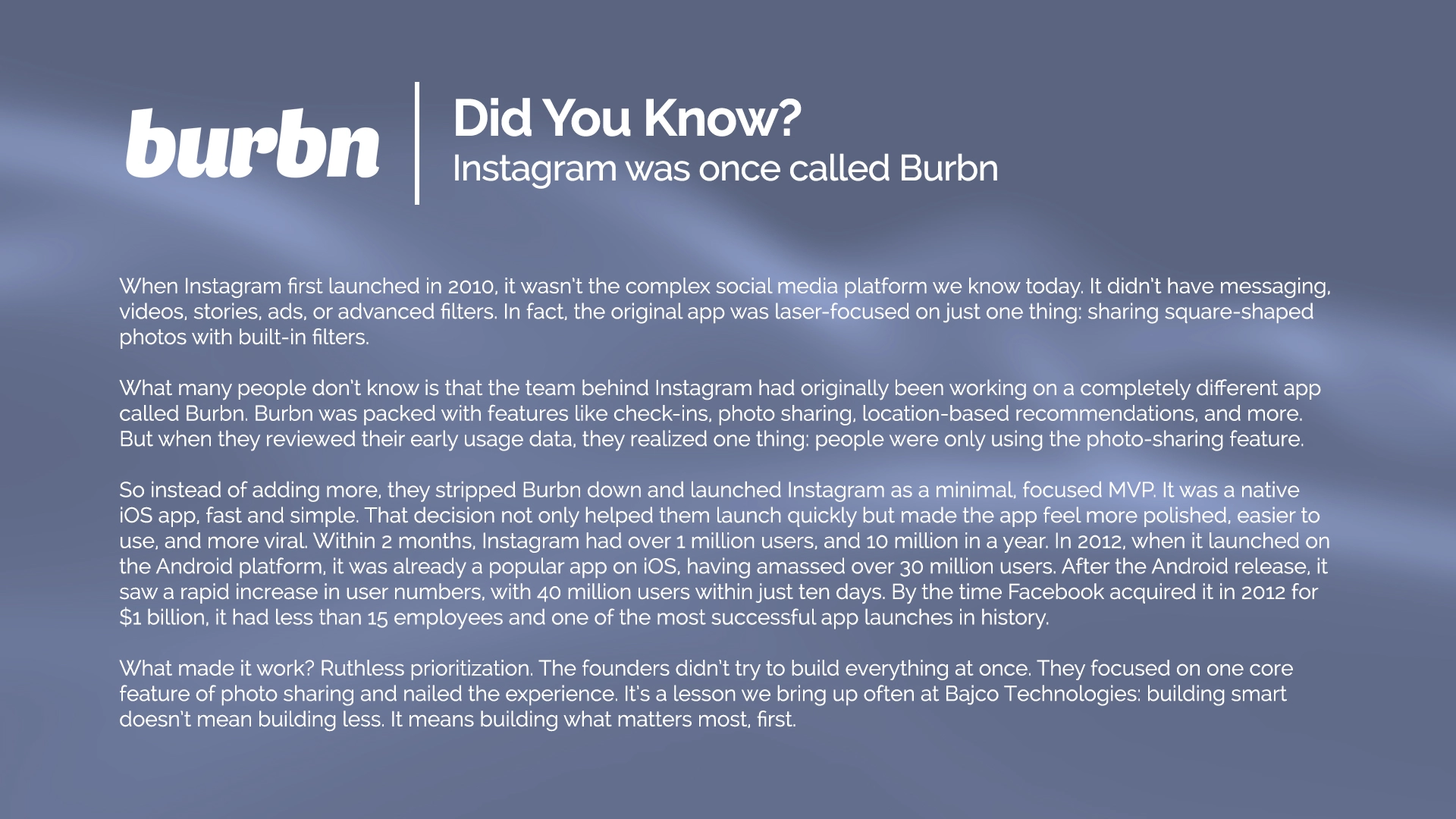
Reuse What Works Instead of Reinventing Everything
Building custom doesn’t mean starting from scratch. A big mistake founders make is assuming everything has to be custom-coded, even login pages, payment systems, or chat interfaces. But if there are trusted, scalable services that do the job, why not use them?
We often integrate Stripe, Firebase, OneSignal, or Auth0, not because we’re cutting corners, but because these services are secure, reliable, and already battle-tested. It also gives our clients fewer things to manage later. That means lower development costs and fewer future headaches.
Cross-Platform Isn’t Always a Shortcut But It Can Be
Flutter and React Native are popular for a reason. If you’re building for both iOS and Android, they can cut development time nearly in half. But they’re not always the right fit.
For apps that rely on smooth animations, native gestures, or iOS-only features like Apple Pay or HealthKit, native Swift is the better path. It might cost more upfront, but it pays off in speed, performance, and long-term scalability.
We’ve helped clients launch MVPs in Flutter to save budget, then later rebuild the iOS version in Swift when they were ready to scale. It’s all about timing and knowing when to optimize, not just where.
Choose Developers Based on Experience, Not Just Price
Low-cost development looks attractive until it costs you more in the long run. We’ve had clients come to us with apps they paid $10,000 to build and then spent $20,000 fixing. The truth is, you can’t afford to build your app twice.
A good development team won’t just code, they’ll challenge your ideas, optimize your flows, and keep you from making expensive mistakes. That alone can save tens of thousands of dollars over time.
It’s also about how a team thinks. Are they just building what you say, or are they invested in your outcome? We approach every build as a business partner and not just as a dev shop. That mindset helps our clients avoid scope creep, delays, and missed opportunities.
Stick to Your Scope and Know What Can Wait
One of the fastest ways to burn through a budget is to keep adding things mid-project. It’s tempting, especially once you start seeing your app come to life. But every new feature changes the timeline, increases testing needs, and adds risk.
The apps that launch on time and on budget usually have one thing in common: discipline. They stick to version 1 goals and save the rest for version 1.1. That doesn’t mean compromising, it means planning smartly.
We use phased rollouts for most of our projects. That means locking the core features first, launching fast, and then adding more based on data. It creates momentum, keeps costs predictable, and helps clients grow with purpose.
Think Beyond the Launch
It’s easy to forget about post-launch costs, but they’re real. You’ll need updates, bug fixes, new feature requests, and support when Apple rolls out a new iOS version. Ignoring that is like buying a car and forgetting you’ll need gas.
A well-maintained app builds user trust. On average, 78% of users uninstall an app within 90 days, underscoring the importance of delivering a compelling user experience early on. That’s why we build systems that are easy to update, modular in structure, and clean in code.
Lowering your development cost doesn’t mean building less, it means building smarter. And that’s where we come in. We work with founders and teams to make smart tech decisions from day one. We help you stay focused, ship faster, and build something solid without draining your entire budget.
Why Bajco Technologies Makes iOS App Development More Affordable
We’re often asked, “Are you affordable?” And our honest answer is “yes”, but not because we cut corners. At Bajco Technologies, we build apps that are affordable because we build them with purpose.
We don’t throw features at your product just to justify a big price tag. We ask the right questions early, help you identify what matters now versus what can wait, and make sure every dollar you spend moves you closer to your goals. That’s where the real savings come from i.e. smart planning, clean code, and a team that treats your app like a business asset, not just a project.
We also don’t believe in locking clients into one-size-fits-all pricing. Whether you’re a startup testing your idea, or a growing company scaling your tech, we offer flexible engagement models and modular build phases that help you move forward at the right pace. You can start lean and scale when the time is right without needing to rebuild everything from scratch.
It’s not about being the cheapest. It’s about being the partner that helps you spend wisely, launch confidently, and build something that lasts.
Let’s Build What Matters in the Smart Way
There’s no magic number when it comes to iOS app development. The cost depends on what you’re building, how you build it, and who you build it with. What matters more than price is whether your app actually does what it’s supposed to, and whether it’s something your users want to keep coming back to.
We’ve worked with all kinds of clients; from startups launching their first product to growing teams rebuilding something that didn’t go as planned. What we’ve learned is that the most successful apps don’t always start big. They start smart. They focus on solving one clear problem, doing it well, and growing from there.
If you’re building an app in 2025, the real goal isn’t just to launch. It’s to launch something solid. Something that runs smoothly, scales easily, and earns trust. That doesn’t mean you need a massive budget. It means you need the right people, the right process, and the discipline to build what matters first.
That’s how we build at Bajco Technologies; with clarity, care, and a clear path forward.
Frequently Asked Questions
How much does iOS app development cost in 2025?
The cost ranges from $20,000 to over $200,000 depending on the app’s complexity, features, and who builds it. Most MVPs fall between $40,000 and $80,000.
Is it cheaper to build iOS apps with Flutter or native iOS?
Flutter can reduce costs if you’re building for both iOS and Android. But for iOS-only apps that require top performance, native Swift development is often a smarter long-term investment.
Can AI help lower iOS app development costs?
Yes, AI tools can speed up development and testing. But adding AI features like chatbots or personalization can raise the budget, so it depends on how you use it.
Thank You for Visiting Bajco Tech!
Thank You for Visiting Bajco Tech!
We’re glad you explored our blog! We hope our insights into technology have been valuable. Stay tuned for more updates and inspiration as we continue to cover the latest innovations and trends. Thanks for being part of the Bajco Tech community!

